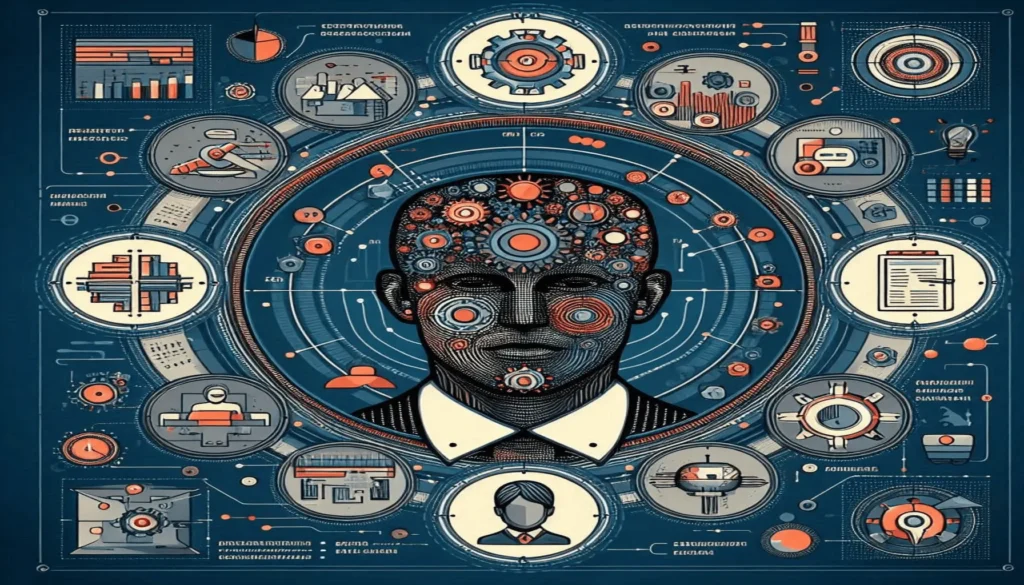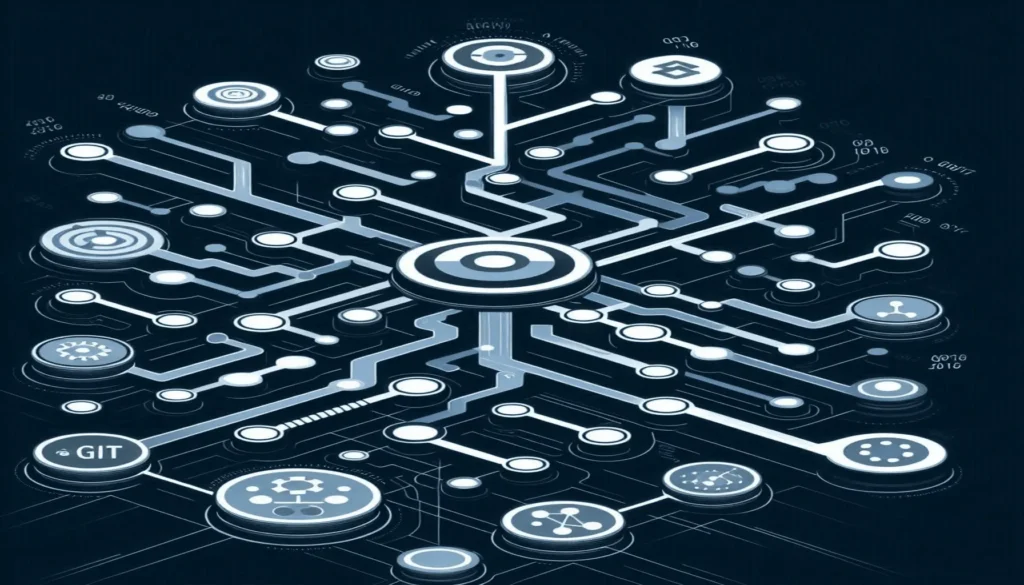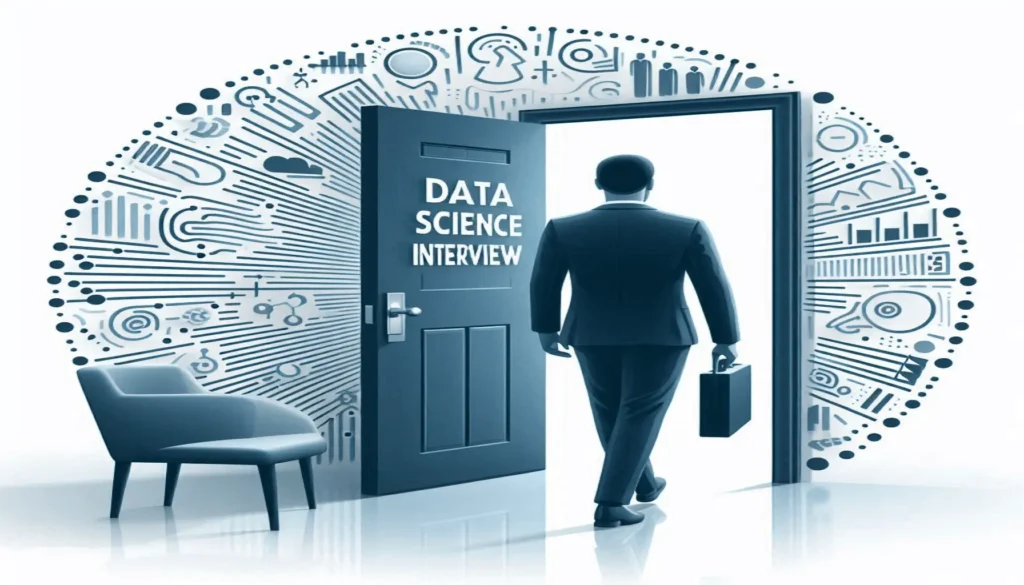How to Become a Data Scientist: Achieve Your Dream

In today’s data-driven world, the role of a data scientist has become increasingly crucial across industries. If you’re wondering how to become a data scientist, you’ve come to the right place. This comprehensive guide will walk you through the essential steps, skills, and resources needed to embark on a successful data science career.
Data science has emerged as one of the most sought-after career paths in recent years, offering endless opportunities across various sectors. As businesses increasingly rely on data-driven decision-making, the demand for skilled data scientists continues to soar. But what exactly is a data scientist, and why should you consider this career path?

A data scientist is a professional who combines expertise in statistics, mathematics, and computer science to extract meaningful insights from complex data sets. They use advanced analytics techniques, machine learning algorithms, and programming skills to solve business problems and drive innovation.
The importance of data science in today’s world cannot be overstated. From healthcare and finance to e-commerce and social media, data scientists are at the forefront of technological advancements, helping organizations make informed decisions and gain a competitive edge.
Why become a data scientist?
- High demand and job security
- Lucrative salaries and career growth opportunities
- Intellectually stimulating and challenging work
- Opportunity to make a significant impact across industries
- Diverse career paths and specializations
As you embark on your journey to become a data scientist, it’s essential to understand that this field requires a unique blend of technical skills, analytical thinking, and creativity. In the following sections, we’ll delve deeper into the role of a data scientist, the essential skills you’ll need to acquire, and the various paths you can take to enter this exciting field.
Link to Harvard Business Review article on data science careers
Now that we’ve outlined the importance of data science and why you might want to pursue this career, let’s take a look at the key steps you’ll need to take on your journey to becoming a data scientist:
Step 1: Learn the Basics
Master mathematics, statistics, and programming fundamentals.
Step 2: Develop Technical Skills
Learn Python, R, SQL, and data visualization tools.
Step 3: Study Machine Learning
Understand algorithms, model training, and evaluation.
Step 4: Practice with Projects
Build a portfolio and participate in Kaggle competitions.
Step 5: Gain Experience
Internships, entry-level positions, or freelance work.
Step 6: Continuous Learning
Stay updated with new technologies and techniques.
This timeline provides a high-level overview of the steps you’ll need to take to become a data scientist. In the following sections, we’ll dive deeper into each of these steps, providing you with detailed information and resources to guide you on your path to becoming a data scientist.
Understanding the Role of a Data Scientist

Before diving into the steps to become a data scientist, it’s crucial to understand what this role entails and how it fits into the broader landscape of data-driven professions.
What does a data scientist do?
A data scientist wears many hats, combining the skills of a mathematician, statistician, and computer scientist. Their primary goal is to extract valuable insights from vast amounts of structured and unstructured data. Here’s a breakdown of their core activities:
- Data collection and cleaning
- Exploratory data analysis
- Building and implementing machine learning models
- Communicating findings to stakeholders
- Developing data-driven solutions to business problems
Data scientists use a variety of tools and techniques, including programming for data science, statistical analysis, and data visualization, to turn raw data into actionable insights.
Key responsibilities
The data science roadmap typically includes the following key responsibilities:
- Data wrangling: Cleaning, organizing, and preprocessing raw data for analysis
- Statistical analysis: Applying statistical methods to identify patterns and trends
- Machine learning: Developing and implementing predictive models and algorithms
- Data visualization: Creating clear, compelling visual representations of data
- Communication: Presenting findings to both technical and non-technical audiences
- Problem-solving: Addressing complex business challenges using data-driven approaches
- Continuous learning: Staying updated with the latest advancements in data science and related fields
Industries that employ data scientists
Data scientists are in high demand across various sectors. Here’s a table showing some of the key industries and how they utilize data science:
| Industry | Data Science Applications |
| Finance | Risk assessment, fraud detection, algorithmic trading |
| Healthcare | Disease prediction, personalized medicine, medical image analysis |
| E-commerce | Customer segmentation, recommendation systems, demand forecasting |
| Social Media | Sentiment analysis, user behavior prediction, content optimization |
| Manufacturing | Predictive maintenance, quality control, supply chain optimization |
| Transportation | Route optimization, autonomous vehicle development, traffic prediction |
Link to IBM’s industry applications of data science
Difference between data scientist, data analyst, and data engineer
While these roles often overlap, they have distinct focuses:
- Data Scientist:
- Combines advanced statistical and mathematical skills with programming expertise
- Develops complex machine learning models and algorithms
- Focuses on predictive analytics and extracting insights from large datasets
- Data Analyst:
- Primarily works with structured data
- Uses statistical techniques to interpret data and generate reports
- Focuses on descriptive analytics and answering specific business questions
- Data Engineer:
- Designs and maintains data pipelines and infrastructure
- Ensures data is accessible, secure, and optimized for analysis
- Focuses on big data technologies and database management
Understanding these distinctions is crucial when deciding which data science career guide to follow. While a data scientist’s role often encompasses aspects of both data analysis and data engineering, it typically requires a broader skill set and a deeper understanding of advanced analytical techniques.
As you progress in your data science learning path, you may find yourself gravitating towards one of these specialized roles. However, having a solid foundation in all three areas will make you a more versatile and valuable professional in the field of data science.
Link to Coursera’s comparison of data roles
Essential Skills for Aspiring Data Scientists

To become a successful data scientist, you’ll need to develop a diverse skill set that combines technical expertise with crucial soft skills. Let’s explore these essential competencies in detail.
Technical Skills
Mathematics and Statistics
A strong foundation in maths for data science is crucial for understanding complex algorithms and interpreting data accurately. Key areas to focus on include:
- Linear algebra
- Calculus
- Probability theory
- Descriptive and inferential statistics
Algebra in data science plays a vital role in manipulating data and understanding relationships between variables. Calculus for data analysis is essential for optimization problems and understanding the fundamentals of machine learning algorithms.
Link to Khan Academy’s Linear Algebra course
Programming Languages (Python, R)
Proficiency in programming is a must for any aspiring data scientist. The two most popular languages in the field are:
- Python: Known for its simplicity and versatility, Python is widely used in data science for tasks ranging from data manipulation to machine learning.
- R: Particularly strong for statistical computing and graphics, R is favored in academia and research.
Both languages have extensive libraries and frameworks for data science tasks. Here’s a comparison of some popular libraries:
| Task | Python Library | R Library |
| Data manipulation | Pandas | dplyr |
| Visualization | Matplotlib, Seaborn | ggplot2 |
| Machine learning | Scikit-learn | caret |
| Deep learning | TensorFlow, PyTorch | Keras |
Link to Codecademy’s Python for Data Science course
Machine Learning and Deep Learning
Machine learning in data science is a core competency that allows you to build predictive models and uncover patterns in data. Key areas to master include:
- Supervised learning algorithms (e.g., regression, classification)
- Unsupervised learning techniques (e.g., clustering, dimensionality reduction)
- Ensemble methods
- Model evaluation and validation
Deep learning extends machine learning capabilities, particularly for complex tasks like image and speech recognition. Familiarize yourself with:
- Neural network architectures
- CNN and RNN models
- Transfer learning techniques
Link to Google’s Machine Learning Crash Course
Data Visualization
The ability to create compelling visualizations is crucial for communicating insights effectively. Focus on:
- Principles of effective data visualization
- Tools like Tableau for data science
- Programming libraries such as Matplotlib, Seaborn, and ggplot2
Visualization techniques to master include:
- Bar charts and histograms
- Scatter plots and line graphs
- Heatmaps and choropleth maps
- Interactive dashboards
Link to Tableau’s free training videos
Big Data Technologies
As datasets grow in size and complexity, familiarity with big data in data science technologies becomes increasingly important. Key areas to explore include:
- Distributed computing frameworks like Apache Hadoop and Spark
- NoSQL databases
- Cloud computing platforms (e.g., AWS, Google Cloud, Azure)
Link to Cloudera’s Introduction to Big Data course
Soft Skills
While technical skills are crucial, soft skills are equally important for a successful data science career.
Problem-Solving
Data scientists are essentially problem solvers. Develop your ability to:
- Break down complex problems into manageable components
- Think creatively to find innovative solutions
- Apply analytical thinking to real-world business challenges
Communication
The ability to communicate complex findings to both technical and non-technical audiences is vital. Focus on:
- Presenting data insights clearly and concisely
- Storytelling with data
- Adapting your communication style to different stakeholders
Critical Thinking
Cultivate a mindset of skepticism and critical analysis:
- Question assumptions and methodologies
- Evaluate the reliability and validity of data sources
- Consider ethical implications of data analysis and AI
Curiosity and Continuous Learning
The field of data science is constantly evolving. To stay relevant:
- Stay updated with the latest trends and technologies
- Participate in online communities and forums
- Attend conferences and workshops
- Engage in personal projects and competitions
Link to Kaggle’s data science competitions
By focusing on developing both your technical and soft skills, you’ll be well-equipped to tackle the challenges and opportunities that come with a career in data science. Remember, becoming a data scientist is a journey of continuous learning and improvement. Embrace the process and stay curious!
Educational Pathways to Become a Data Scientist

When it comes to learning maths for data science from scratch and acquiring the necessary skills to become a data scientist, there are multiple educational pathways you can pursue. Each option has its own advantages and considerations, and the best choice depends on your background, learning style, and career goals.
Formal Education Options
Formal education provides a structured learning environment and comprehensive coverage of data science fundamentals. Here are the main options:
- Bachelor’s Degree in Relevant Fields
- Programs: Computer Science, Statistics, Mathematics, Data Science
- Duration: 3-4 years
- Advantages:
- Builds a strong foundation in core concepts
- Provides networking opportunities with peers and professors
- Often includes internship opportunities
- Master’s Degree in Data Science or Related Areas
- Programs: Data Science, Business Analytics, Machine Learning
- Duration: 1-2 years
- Advantages:
- Specialized focus on advanced data science topics
- Often includes industry collaborations and projects
- Can lead to higher starting salaries
- PhD Programs
- Focus: Advanced research in specific areas of data science
- Duration: 4-6 years
- Advantages:
- Ideal for those interested in research or academia
- Opportunity to contribute to cutting-edge developments in the field
- Can lead to leadership positions in industry research teams
| Degree | Duration | Focus | Career Prospects |
| Bachelor’s | 3-4 years | Broad foundation | Entry-level data analyst or junior data scientist |
| Master’s | 1-2 years | Specialized skills | Data scientist, machine learning engineer |
| PhD | 4-6 years | Advanced research | Senior data scientist, research scientist, professor |
Self-Learning and Online Courses
For those who prefer a more flexible approach or are looking to transition from another field, self-learning and online courses offer excellent opportunities to acquire data science skills.
- MOOCs (Massive Open Online Courses)
- Platforms: Coursera, edX, Udacity
- Advantages:
- Flexibility to learn at your own pace
- Access to courses from top universities and institutions
- Often more affordable than traditional education
Some popular MOOCs for aspiring data scientists include:
- Machine Learning by Andrew Ng (Stanford University on Coursera)
- Data Science Specialization (Johns Hopkins University on Coursera)
- MicroMasters Program in Statistics and Data Science (MIT on edX)
- Bootcamps and Intensive Programs
- Duration: Typically 3-6 months
- Advantages:
- Immersive, hands-on learning experience
- Often include career support and job placement assistance
- Quick way to gain practical skills
Popular data science bootcamps:
Certifications and Their Value
Certifications can complement your education or serve as a way to validate your skills to potential employers. While not always necessary, they can be particularly valuable for those transitioning from other fields or looking to specialize in specific areas of data science.
Notable Data Science Certifications:
- Google Data Analytics Professional Certificate
- Focus: Data analytics fundamentals
- Learn more
- IBM Data Science Professional Certificate
- Focus: Comprehensive data science skills
- Learn more
- Microsoft Certified: Azure Data Scientist Associate
- Focus: Machine learning on Microsoft Azure
- Learn more
- Cloudera Certified Associate (CCA) Data Analyst
- Focus: SQL and data analysis skills
When considering certifications, keep in mind that their value can vary depending on the industry and specific job requirements. It’s essential to research which certifications are most relevant and respected in your target field or company.
The key to becoming a successful data scientist is not just about acquiring certifications, but about gaining practical experience and continuously learning. Certifications can be a great way to structure your learning and validate your skills, but they should be complemented with real-world projects and a deep understanding of the underlying concepts.
Dr. Emily Chen, Senior Data Scientist at TechInnovate Inc.
As you navigate your educational journey to become a data scientist, remember that the field is constantly evolving. Regardless of the path you choose, cultivating a mindset of lifelong learning and staying updated with the latest trends and technologies is crucial for long-term success in data science.
Building a Strong Foundation in Mathematics

A solid understanding of mathematics is crucial for anyone aspiring to become a data scientist. Maths for data science forms the backbone of many data analysis techniques, machine learning algorithms, and statistical models. In this section, we’ll explore the key mathematical areas you need to master to excel in your data science journey.
Linear Algebra
Linear algebra is fundamental to many data science and machine learning concepts. It’s essential for understanding how algorithms work and for efficiently manipulating large datasets.
Key topics in linear algebra for data science include:
- Vectors and matrices
- Matrix operations (addition, multiplication, transposition)
- Eigenvalues and eigenvectors
- Singular Value Decomposition (SVD)
- Principal Component Analysis (PCA)
Practical application: Linear algebra is used in dimensionality reduction techniques like PCA, which is crucial for handling high-dimensional datasets and feature extraction in machine learning models.
Link to MIT OpenCourseWare Linear Algebra course
Calculus
Calculus plays a vital role in optimizing machine learning models and understanding the behavior of complex functions. Calculus for data analysis is particularly important when working with gradient-based optimization algorithms.
Key calculus concepts for data scientists:
- Derivatives and partial derivatives
- Integrals and multiple integrals
- Gradient descent and its variations
- Taylor series expansions
- Optimization techniques (e.g., Newton’s method)
Practical application: Gradient descent, a fundamental optimization algorithm in machine learning, relies heavily on calculus principles to minimize the cost function and improve model performance.
Link to Khan Academy Calculus course
Probability and Statistics
Probability and statistics are at the core of data science. They provide the tools to analyze data, make inferences, and quantify uncertainty in your models.
Essential probability and statistics topics include:
- Probability distributions (e.g., normal, binomial, Poisson)
- Descriptive statistics (mean, median, mode, variance)
- Inferential statistics (hypothesis testing, confidence intervals)
- Bayesian statistics
- Regression analysis
Practical application: Statistical techniques are used in A/B testing, which is crucial for making data-driven decisions in product development and marketing strategies.
Here’s a table summarizing some common probability distributions and their applications in data science:
| Distribution | Description | Common Applications |
| Normal | Bell-shaped curve | Height, weight, test scores |
| Binomial | Discrete, fixed number of trials | Customer churn, conversion rates |
| Poisson | Discrete, rate of rare events | Website traffic, customer arrivals |
| Exponential | Continuous, time between events | Time between failures, customer wait times |
Link to Statistics and Probability course on Coursera
Optimization Techniques
Optimization is crucial in data science for fine-tuning models and finding the best solutions to complex problems. Understanding various optimization techniques will help you improve the efficiency and performance of your algorithms.
Key optimization concepts for data scientists:
- Convex optimization
- Stochastic optimization
- Constrained optimization
- Multi-objective optimization
- Heuristic and metaheuristic algorithms
Practical application: Optimization techniques are used in hyperparameter tuning for machine learning models, helping to find the best combination of parameters that maximize model performance.
To strengthen your mathematical foundation for data science, consider the following tips:
- Practice regularly with online resources like Khan Academy or Brilliant.org
- Solve real-world problems using mathematical concepts
- Participate in online math competitions or challenges
- Join study groups or online forums to discuss mathematical concepts with peers
- Apply mathematical concepts in your data science projects to reinforce learning
Remember, building a strong foundation in mathematics is an ongoing process. As you progress in your data science journey, you’ll find that these mathematical concepts become increasingly relevant and valuable in solving complex data-driven problems.
Link to Optimization course on edX
By mastering these mathematical concepts, you’ll be well-equipped to tackle the challenges of data science and develop a deeper understanding of the algorithms and techniques used in the field. In the next section, we’ll explore how to apply these mathematical foundations to programming for data science.
Mastering Programming for Data Science

Programming skills are the backbone of a data scientist’s toolkit. While there are several programming languages used in data science, three stand out as essential: Python, R, and SQL. Let’s dive into each of these languages and explore their applications in data science.
Python for Data Science
Python has become the de facto language for data science due to its versatility, ease of use, and robust ecosystem of libraries. As an aspiring data scientist, mastering Python should be high on your priority list.
Key Libraries for Data Science in Python
Python’s strength lies in its extensive collection of libraries tailored for data science tasks. Here are some of the most important ones:
- NumPy: The foundation for numerical computing in Python
- Pandas: Essential for data manipulation and analysis
- Scikit-learn: A comprehensive machine learning library
- Matplotlib and Seaborn: Powerful data visualization tools
- TensorFlow and PyTorch: Deep learning frameworks
Let’s look at a quick example of using Pandas for data manipulation:
import pandas as pd
# Load a dataset
df = pd.read_csv('dataset.csv')
# Display the first few rows
print(df.head())
# Perform basic data analysis
print(df.describe())
# Filter data
filtered_df = df[df['column_name'] > 100]Data Manipulation and Analysis with Python
Python excels in data manipulation and analysis tasks. Here are some common operations you’ll perform:
- Data cleaning and preprocessing
- Feature engineering
- Exploratory data analysis (EDA)
- Statistical analysis and hypothesis testing
- Time series analysis
Link to Python Data Science Handbook
R for Statistical Computing and Graphics
While Python is versatile, R shines in statistical analysis and data visualization. Many data scientists use both languages, leveraging their respective strengths.
Data Visualization with ggplot2
R’s ggplot2 library is renowned for creating publication-quality visualizations. Here’s a simple example:
library(ggplot2)
# Create a scatter plot
ggplot(data = mtcars, aes(x = wt, y = mpg)) +
geom_point() +
ggtitle("Car Weight vs. Miles Per Gallon") +
xlab("Weight (1000 lbs)") +
ylab("Miles Per Gallon")Statistical Analysis in R
R’s statistical capabilities are unparalleled. Some key areas include:
- Descriptive statistics
- Inferential statistics (t-tests, ANOVA, regression analysis)
- Time series analysis
- Bayesian statistics
Link to R for Data Science book
SQL for Database Management
While Python and R are essential for analysis, SQL (Structured Query Language) is crucial for working with databases. As a data scientist, you’ll often need to extract data from various sources.
Key SQL skills for data scientists include:
- Writing complex queries to extract and filter data
- Joining multiple tables
- Aggregating and summarizing data
- Creating and modifying database structures
Here’s a simple SQL query example:
SELECT
product_name,
AVG(price) as avg_price,
COUNT(*) as total_sales
FROM
sales
GROUP BY
product_name
HAVING
total_sales > 100
ORDER BY
avg_price DESC
LIMIT 10;
Link to SQL tutorial for data science
To become proficient in these programming languages, consider the following learning approach:
- Start with Python basics and gradually move to data science libraries
- Learn R for statistical analysis and advanced visualizations
- Master SQL for database operations
- Work on projects that combine these languages
- Participate in coding challenges on platforms like HackerRank or LeetCode
Remember, programming for data science is not just about syntax; it’s about problem-solving and data manipulation. As you learn these languages, focus on applying them to real-world datasets and problems.
By mastering Python, R, and SQL, you’ll have a solid foundation in programming for data science, enabling you to tackle complex data analysis tasks and advance your career as a data scientist.
Developing Data Wrangling and Cleaning Skills

Data wrangling, also known as data munging or data preparation, is a critical skill for any aspiring data scientist. It’s often said that data scientists spend up to 80% of their time cleaning and preparing data. Let’s dive into the essential aspects of data wrangling techniques and why they’re crucial in your journey to become a data scientist.
Importance of data preparation
Data preparation is the foundation of any successful data science project. Here’s why it’s so important:
- Garbage in, garbage out: Clean data leads to accurate models and reliable insights.
- Efficiency: Well-prepared data streamlines the analysis process.
- Consistency: Standardized data ensures comparability across different sources.
- Accuracy: Proper preparation helps identify and correct errors in the dataset.
- Compliance: Clean data helps meet regulatory requirements in industries like finance and healthcare.
Link to IBM’s guide on data preparation
Techniques for handling missing data
Missing data is a common challenge in real-world datasets. Here are some techniques to handle it:
- Deletion: Remove rows or columns with missing values (use cautiously).
- Imputation: Fill in missing values using statistical methods.
- Prediction: Use machine learning models to predict missing values.
- Advanced methods: Employ multiple imputation or maximum likelihood estimation for complex cases.
| Method | Pros | Cons |
| Deletion | Simple, fast | Can lead to loss of important information |
| Imputation | Preserves data size | May introduce bias if done incorrectly |
| Prediction | Can be highly accurate | Computationally intensive |
| Advanced methods | Statistically robust | Complex to implement |
Data transformation and feature engineering
Data transformation and feature engineering are crucial steps in preparing your data for analysis and modeling. These processes involve:
- Normalization and standardization: Scaling numerical features to a common range.
- Encoding categorical variables: Converting categorical data into numerical format (e.g., one-hot encoding, label encoding).
- Feature creation: Generating new features from existing ones to capture important relationships.
- Dimensionality reduction: Reducing the number of features while preserving important information (e.g., PCA, t-SNE).
- Handling skewed data: Applying transformations like log or Box-Cox to normalize distributions.
Feature engineering is particularly important in machine learning for data science. It involves creating new features or modifying existing ones to improve model performance. This process often requires domain knowledge and creativity.
Link to Google Cloud’s guide on feature engineering
Tools for efficient data wrangling
To become proficient in data cleaning for data science projects, familiarize yourself with these popular tools:
- Python libraries:
- Pandas: The go-to library for data manipulation in Python
- NumPy: For numerical computing and array operations
- Scikit-learn: Offers preprocessing tools for machine learning
- R packages:
- dplyr: For data manipulation and transformation
- tidyr: For tidying messy data
- data.table: For fast aggregation of large datasets
- SQL: Essential for working with relational databases and performing data transformations
- Apache Spark: For big data processing and wrangling
- OpenRefine: A powerful tool for cleaning messy data
- Trifacta: A data wrangling platform with a user-friendly interface
Here’s a simple example of data cleaning using Python and Pandas:
import pandas as pd
import numpy as np
# Load the dataset
df = pd.read_csv('messy_data.csv')
# Handle missing values
df['column_name'].fillna(df['column_name'].mean(), inplace=True)
# Remove duplicates
df.drop_duplicates(inplace=True)
# Normalize a numerical column
df['numeric_column'] = (df['numeric_column'] - df['numeric_column'].min()) / (df['numeric_column'].max() - df['numeric_column'].min())
# Encode categorical variables
df = pd.get_dummies(df, columns=['categorical_column'])
# Save the cleaned dataset
df.to_csv('cleaned_data.csv', index=False)Mastering data wrangling and cleaning skills is essential for anyone looking to become a successful data scientist. These techniques form the backbone of any data science project and directly impact the quality of your analyses and models. As you progress in your data science learning path, make sure to practice these skills regularly with real-world datasets.
Link to Kaggle’s data cleaning challenge
By developing strong data wrangling skills, you’ll be well-equipped to tackle the challenges of real-world data and set yourself apart in your journey to become a data scientist.
Diving into Machine Learning

Machine learning is at the heart of data science, enabling computers to learn from data and make predictions or decisions without being explicitly programmed. As an aspiring data scientist, understanding machine learning concepts and techniques is crucial for your success in the field.
Supervised Learning Algorithms
Supervised learning is a type of machine learning where the algorithm learns from labeled data. The goal is to learn a function that maps input variables to output variables. Here are some key supervised learning algorithms you should be familiar with:
- Linear Regression: Used for predicting continuous values
- Logistic Regression: Used for binary classification problems
- Decision Trees: Versatile algorithm for both classification and regression
- Random Forests: Ensemble method that combines multiple decision trees
- Support Vector Machines (SVM): Effective for both linear and non-linear classification
- K-Nearest Neighbors (KNN): Simple algorithm based on feature similarity
- Naive Bayes: Probabilistic classifier based on Bayes’ theorem
When working on data science projects, you’ll often start with these fundamental algorithms before moving on to more complex techniques.
Link to Scikit-learn’s supervised learning guide
Unsupervised Learning Techniques
Unsupervised learning deals with unlabeled data, aiming to discover hidden patterns or structures within the data. Key unsupervised learning techniques include:
- Clustering Algorithms:
- K-Means Clustering
- Hierarchical Clustering
- DBSCAN (Density-Based Spatial Clustering of Applications with Noise)
- Dimensionality Reduction:
- Principal Component Analysis (PCA)
- t-SNE (t-Distributed Stochastic Neighbor Embedding)
- Association Rule Learning:
- Apriori Algorithm
- FP-Growth Algorithm
- Anomaly Detection:
- Isolation Forest
- One-Class SVM
Understanding these unsupervised algorithms in data science is essential for exploring data, identifying patterns, and preprocessing data for other machine learning tasks.
Model Evaluation and Validation
Evaluating and validating machine learning models is crucial to ensure their performance and generalizability. Here are some key concepts and techniques:
- Performance Metrics:
- For Classification: Accuracy, Precision, Recall, F1-Score, ROC-AUC
- For Regression: Mean Squared Error (MSE), Root Mean Squared Error (RMSE), R-squared
- Cross-Validation Techniques:
- K-Fold Cross-Validation
- Stratified K-Fold Cross-Validation
- Leave-One-Out Cross-Validation
- Overfitting and Underfitting:
- Understanding the bias-variance tradeoff
- Techniques to prevent overfitting (regularization, early stopping)
- Learning Curves:
- Analyzing model performance as a function of training set size
Here’s a simple table summarizing when to use different evaluation metrics:
| Problem Type | Recommended Metrics |
| Binary Classification | Accuracy, Precision, Recall, F1-Score, ROC-AUC |
| Multi-class Classification | Accuracy, Macro/Micro/Weighted F1-Score |
| Regression | MSE, RMSE, R-squared, Mean Absolute Error (MAE) |
Link to Google’s Machine Learning Crash Course on Model Evaluation
Feature Selection and Dimensionality Reduction
Feature selection and dimensionality reduction are crucial steps in the machine learning pipeline, helping to improve model performance and reduce computational complexity.
Feature Selection Techniques
- Filter Methods:
- Correlation-based feature selection
- Chi-squared test
- Information Gain
- Wrapper Methods:
- Recursive Feature Elimination (RFE)
- Forward/Backward Feature Selection
- Embedded Methods:
- Lasso Regularization
- Random Forest Feature Importance
Dimensionality Reduction Techniques
- Principal Component Analysis (PCA): Linear technique to reduce dimensions while preserving variance
- t-SNE: Non-linear technique for visualizing high-dimensional data
- Autoencoders: Neural network-based approach for non-linear dimensionality reduction
The curse of dimensionality is that all data becomes sparse in high dimensions.
Richard Bellman
When working on machine learning in data science projects, it’s essential to carefully consider which features to include and how to reduce dimensionality effectively. This not only improves model performance but also helps in visualizing and understanding complex datasets.
As you continue your journey to become a data scientist, mastering these machine learning concepts will be crucial. Practice implementing these algorithms using libraries like Scikit-learn and TensorFlow, and don’t forget to participate in Kaggle competitions to apply your skills to real-world problems.
Link to Towards Data Science article on Feature Selection techniques
Exploring Deep Learning and Neural Networks

As you progress in your journey to become a data scientist, you’ll inevitably encounter deep learning and neural networks. These advanced techniques have revolutionized the field of artificial intelligence and are essential components of modern data science projects.
Fundamentals of Neural Networks
Neural networks are the backbone of deep learning, inspired by the structure and function of the human brain. Understanding these fundamentals is crucial for mastering deep learning in data science.
Key concepts of neural networks include:
- Neurons and layers
- Activation functions
- Weights and biases
- Forward and backward propagation
- Loss functions and optimization algorithms
To grasp these concepts, consider studying resources like:
- Deep Learning Specialization on Coursera
- “Deep Learning” by Ian Goodfellow, Yoshua Bengio, and Aaron Courville
Convolutional Neural Networks (CNNs)
CNNs have revolutionized computer vision tasks and are essential for any data scientist working with image data. These networks are particularly adept at recognizing patterns in visual data.
Key applications of CNNs include:
- Image classification
- Object detection
- Facial recognition
- Medical image analysis
To practice implementing CNNs, try working on projects like:
- Building an image classifier using the CIFAR-10 dataset
- Developing a facial recognition system
- Creating a style transfer application
Recurrent Neural Networks (RNNs)
RNNs are designed to work with sequential data, making them ideal for tasks involving time series or natural language processing. As you delve deeper into machine learning in data science, understanding RNNs will be crucial.
Common applications of RNNs include:
- Natural language processing
- Speech recognition
- Time series forecasting
- Machine translation
To gain hands-on experience with RNNs, consider projects such as:
- Building a sentiment analysis model for movie reviews
- Developing a stock price prediction system
- Creating a chatbot using sequence-to-sequence models
Transfer Learning and Pre-trained Models
Transfer learning is a powerful technique that allows data scientists to leverage pre-trained models for new tasks, significantly reducing training time and improving performance.
Benefits of transfer learning include:
- Faster model development
- Improved performance on small datasets
- Reduced computational requirements
Popular pre-trained models for transfer learning:
| Model Name | Architecture | Primary Use Case |
| VGG16 | CNN | Image Classification |
| ResNet | CNN | Image Recognition |
| BERT | Transformer | Natural Language Processing |
| GPT-3 | Transformer | Text Generation |
To implement transfer learning in your projects:
- Choose a pre-trained model relevant to your task
- Freeze the pre-trained layers
- Add custom layers for your specific problem
- Fine-tune the model on your dataset
As you explore deep learning and neural networks, remember that practical experience is key. Participate in Kaggle competitions related to deep learning, contribute to open-source projects, and build your own portfolio of data science projects showcasing your skills in this area.
By mastering these advanced techniques, you’ll be well-equipped to tackle complex problems and stand out in your journey to become a data scientist. The field of deep learning is constantly evolving, so stay curious and keep learning!
Data Visualization and Storytelling

In the world of data science, the ability to effectively visualize data and communicate insights is just as important as the technical skills of data analysis. Data visualization is a crucial aspect of the data science process, allowing complex information to be presented in a clear, engaging, and easily digestible format. Let’s dive into the principles of effective data visualization, explore some popular tools, and discuss how to communicate insights to non-technical audiences.
Principles of Effective Data Visualization
Creating impactful visualizations goes beyond simply making charts and graphs. It requires a deep understanding of design principles and human perception. Here are some key principles to keep in mind:
- Clarity: The visualization should clearly convey the intended message without unnecessary complexity.
- Accuracy: Ensure that the visualization accurately represents the data without distortion.
- Efficiency: Use the minimum amount of visual elements necessary to convey the information.
- Aesthetics: Create visually appealing graphics that engage the viewer.
- Context: Provide necessary context to help viewers understand the significance of the data.
Link to Edward Tufte’s principles of data visualization
When creating visualizations, consider the following best practices:
- Choose the appropriate chart type for your data and message
- Use color effectively to highlight important information
- Avoid cluttering the visualization with unnecessary elements
- Label axes and data points clearly
- Include a title and legend when necessary
- Consider the audience and purpose of the visualization
Tools for Creating Impactful Visualizations
Data scientists have a wide range of tools at their disposal for creating visualizations. Here are some of the most popular options:
Tableau
Tableau is a powerful data visualization tool that allows users to create interactive dashboards and reports without extensive programming knowledge. Key features:
- Drag-and-drop interface
- Wide range of chart types and customization options
- Ability to connect to various data sources
- Strong community and learning resources
Link to Tableau’s official website
Power BI
Microsoft’s Power BI is another popular business intelligence tool that enables users to create visually appealing reports and dashboards. Key features:
- Integration with other Microsoft products
- Natural language query capabilities
- AI-powered insights
- Customizable visualizations
Link to Power BI’s official website
Matplotlib and Seaborn in Python
For data scientists who prefer a more programmatic approach, Python libraries like Matplotlib and Seaborn offer powerful visualization capabilities. Matplotlib:
- Highly customizable
- Wide range of plot types
- Integration with NumPy and Pandas
Seaborn
- Built on top of Matplotlib
- Attractive default styles
- Statistical plotting functions
Link to Matplotlib documentation Link to Seaborn documentation
Here’s a comparison table of these visualization tools:
| Tool | Ease of Use | Customization | Interactivity | Programming Required |
| Tableau | High | Medium | High | Low |
| Power BI | High | Medium | High | Low |
| Matplotlib | Medium | High | Low | Yes |
| Seaborn | Medium | Medium | Low | Yes |
Communicating Insights to Non-Technical Audiences
As a data scientist, you’ll often need to present your findings to stakeholders who may not have a technical background. Here are some tips for effectively communicating insights:
- Know your audience: Understand their level of technical knowledge and tailor your presentation accordingly.
- Focus on the story: Use your visualizations to tell a compelling story about the data and its implications.
- Use simple language: Avoid jargon and technical terms when possible. Explain complex concepts in simple terms.
- Highlight key takeaways: Clearly state the main insights and their significance to the business or project.
- Use analogies: Compare complex ideas to familiar concepts to make them more relatable.
- Provide context: Explain why the insights matter and how they can be applied to solve real-world problems.
- Be prepared for questions: Anticipate potential questions and have more detailed information ready if needed.
Remember, the goal of data visualization and storytelling is not just to present data, but to inspire action and drive decision-making. By mastering these skills, you’ll be able to translate complex analyses into actionable insights, making you an invaluable asset in any data science role.
Link to Harvard Business Review article on data storytelling
As you continue your journey to become a data scientist, focus on developing your data visualization skills alongside your analytical abilities. Practice creating visualizations with different tools, study effective examples, and seek feedback on your work. With time and experience, you’ll be able to create compelling visual stories that bring your data to life and drive meaningful change in your organization.
Big Data Technologies and Cloud Computing

As data volumes continue to grow exponentially, big data technologies and cloud computing have become essential components of the data science toolkit. In this section, we’ll explore the key concepts and tools that every aspiring data scientist should be familiar with to handle large-scale data processing and analysis.
Introduction to Big Data Concepts
Big data refers to extremely large and complex datasets that traditional data processing applications can’t handle effectively. The concept of big data is often described using the “Five Vs”:
- Volume: The sheer amount of data generated and collected
- Velocity: The speed at which new data is generated and processed
- Variety: The different types and sources of data
- Veracity: The trustworthiness and quality of the data
- Value: The insights and benefits derived from the data
Understanding these concepts is crucial for aspiring data scientists, as they form the foundation for working with big data technologies.
Link to IBM’s introduction to big data
Hadoop Ecosystem
The Hadoop ecosystem is a collection of open-source software utilities designed to solve big data problems. At its core is the Hadoop Distributed File System (HDFS) and the MapReduce programming model. Here are some key components of the Hadoop ecosystem:
| Component | Description |
| HDFS | Distributed file system for storing large datasets |
| MapReduce | Programming model for processing large datasets |
| YARN | Resource management and job scheduling |
| Hive | Data warehouse infrastructure for querying and analyzing large datasets |
| Pig | High-level platform for creating MapReduce programs |
| HBase | NoSQL database for random, real-time read/write access to big data |
To become proficient in the Hadoop ecosystem, aspiring data scientists should focus on:
- Understanding the architecture of HDFS and MapReduce
- Learning how to write MapReduce jobs
- Gaining experience with Hive for SQL-like queries on big data
- Exploring Pig for data flow and processing
Link to Apache Hadoop official documentation
Apache Spark for Large-Scale Data Processing
Apache Spark has emerged as a powerful tool for large-scale data processing, offering significant performance improvements over traditional MapReduce jobs. Key features of Spark include:
- In-memory computing: Allows for faster data processing
- Support for multiple programming languages: Python, Java, Scala, and R
- Unified platform: Combines batch processing, real-time streaming, machine learning, and graph processing
- Rich ecosystem: Includes libraries like Spark SQL, MLlib, and GraphX
For data scientists looking to master Spark, consider the following learning path:
- Learn the basics of Spark’s RDD (Resilient Distributed Dataset) API
- Explore Spark SQL for structured data processing
- Dive into Spark Streaming for real-time data analysis
- Utilize MLlib for distributed machine learning tasks
- Gain experience with GraphX for graph-parallel computation
Link to Apache Spark official documentation
Cloud Platforms (AWS, Google Cloud, Azure)
Cloud platforms have revolutionized the way data scientists work with big data, offering scalable and cost-effective solutions for data storage, processing, and analysis. The three major cloud providers are:
- Amazon Web Services (AWS)
- Google Cloud Platform (GCP)
- Microsoft Azure
Each platform offers a range of services tailored for data science and big data processing:
| Cloud Platform | Key Services for Data Science |
| AWS | S3, EC2, EMR, SageMaker, Redshift |
| Google Cloud | BigQuery, Dataflow, AI Platform, Dataproc |
| Azure | Azure Databricks, HDInsight, Machine Learning Studio |
To become proficient in cloud computing for data science:
- Familiarize yourself with the basic concepts of cloud computing
- Learn how to set up and manage virtual machines in the cloud
- Gain experience with cloud-based big data services (e.g., AWS EMR, Google Dataproc)
- Explore cloud-based machine learning platforms (e.g., AWS SageMaker, Google AI Platform)
- Understand best practices for data security and cost management in the cloud
Link to AWS Machine Learning resource center
By mastering these big data technologies and cloud computing platforms, aspiring data scientists will be well-equipped to handle the challenges of processing and analyzing large-scale datasets in real-world scenarios. Remember that the field of big data is constantly evolving, so it’s essential to stay updated with the latest trends and technologies through continuous learning and practical experience.
Version Control and Collaboration Tools

In the world of data science, collaboration and code management are crucial for successful projects. As you learn how to become a data scientist, mastering version control and collaboration tools will significantly enhance your productivity and teamwork abilities. Let’s explore the essential aspects of these tools and practices.
Basics of Git and GitHub
Git is a distributed version control system that has become the industry standard for managing code and tracking changes. GitHub, on the other hand, is a web-based platform that hosts Git repositories and provides additional collaboration features. Understanding these tools is crucial for any aspiring data scientist.
Key concepts to master in Git:
- Repositories
- Commits
- Branches
- Merging
- Pull requests
To get started with Git and GitHub, follow these steps:
- Install Git on your local machine
- Create a GitHub account
- Set up your first repository
- Learn basic Git commands (git add, git commit, git push, git pull)
- Practice branching and merging
Link to Git documentation for beginners
Here’s a table of essential Git commands every data scientist should know:
| Command | Description |
| git init | Initialize a new Git repository |
| git clone | Create a copy of a remote repository |
| git add | Stage changes for commit |
| git commit | Record changes to the repository |
| git push | Upload local repository content to a remote repository |
| git pull | Fetch and download content from a remote repository |
| git branch | List, create, or delete branches |
| git merge | Merge changes from different branches |
Collaborative Coding Practices
Effective collaboration is key to successful data science projects. Here are some best practices for collaborative coding:
- Use clear and consistent coding standards: Adopt a consistent style guide for your team to ensure code readability and maintainability.
- Write meaningful commit messages: Provide clear and concise descriptions of the changes made in each commit.
- Implement code reviews: Regularly review each other’s code to catch errors, share knowledge, and improve overall code quality.
- Utilize branching strategies: Implement a branching model like GitFlow to manage features, releases, and hotfixes effectively.
- Document your code: Write clear comments and maintain up-to-date documentation for your projects.
- Use issue tracking: Leverage GitHub Issues or similar tools to track bugs, feature requests, and project tasks.
- Implement continuous integration: Set up automated testing and deployment pipelines to catch issues early and ensure code quality.
Link to GitHub’s guide on collaborative coding
Project Management Tools for Data Science Teams
Effective project management is crucial for data science teams to stay organized, track progress, and meet deadlines. Here are some popular project management tools used in data science:
- Jira: A comprehensive project management tool that supports Agile methodologies like Scrum and Kanban.
- Trello: A visual collaboration tool that uses boards, lists, and cards to organize and prioritize projects.
- Asana: A flexible work management platform that helps teams organize, track, and manage their work.
- Microsoft Project: A powerful project management software that offers advanced scheduling, resource management, and reporting features.
- Slack: While primarily a communication tool, Slack can be integrated with various project management apps for seamless collaboration.
When choosing a project management tool for your data science team, consider the following factors:
- Team size and structure
- Project complexity
- Integration with existing tools (e.g., GitHub, Jupyter Notebooks)
- Reporting and analytics capabilities
- Cost and scalability
Pro tip: Many data science teams use a combination of tools to manage their projects effectively. For example, you might use GitHub for version control, Jira for task tracking, and Slack for team communication.
By mastering version control with Git and GitHub, adopting collaborative coding practices, and utilizing effective project management tools, you’ll be well-equipped to work efficiently in data science teams. These skills are essential for anyone looking to become a data scientist and thrive in this collaborative field.
Remember, as you progress in your journey to become a data scientist, continuously improving your collaboration and project management skills will make you a valuable asset to any data science team.
Read also: Master Project Management Tools: 2024 Expert Guide
Building a Portfolio and Gaining Practical Experience

As you progress on your journey to become a data scientist, one of the most crucial steps is building a strong portfolio and gaining hands-on experience. This section will explore various ways to showcase your skills and stand out in the competitive job market.
Personal Projects and Case Studies
Personal projects are an excellent way to demonstrate your creativity, problem-solving abilities, and technical skills. They allow you to apply the concepts you’ve learned and tackle real-world problems that interest you. Here are some tips for developing impactful personal projects:
- Choose diverse topics that showcase different skills (e.g., machine learning, data visualization, natural language processing)
- Document your process, including the problem statement, methodology, and results
- Use real-world datasets or collect your own data
- Present your findings in a clear, visually appealing manner
- Host your projects on GitHub and include detailed README files
Case Study Example: Predictive Maintenance for Manufacturing Equipment
In this project, you could analyze sensor data from industrial machinery to predict equipment failures before they occur. This showcases your skills in time series analysis, machine learning, and industry-specific problem-solving.
Link to Towards Data Science article on building a data science portfolio
Participating in Kaggle Competitions
Kaggle, the world’s largest data science community, offers an excellent platform for aspiring data scientists to gain practical experience and showcase their skills. Here’s why participating in Kaggle competitions is valuable:
- Exposure to real-world datasets and problems
- Opportunity to learn from and collaborate with experienced data scientists
- Chance to benchmark your skills against others in the field
- Potential to win prizes and recognition
Top Kaggle Competitions for Beginners:
- Titanic: Machine Learning from Disaster
- House Prices: Advanced Regression Techniques
- Digit Recognizer
- Natural Language Processing with Disaster Tweets
Link to Kaggle’s Getting Started page
Contributing to Open-Source Projects
Contributing to open-source projects is an excellent way to gain experience, build your network, and give back to the data science community. Here are some benefits of open-source contributions:
- Collaborate with experienced developers and data scientists
- Improve your coding skills and learn best practices
- Gain exposure to large-scale projects and diverse codebases
- Enhance your GitHub profile and build your online presence
Popular Open-Source Data Science Projects:
| Project Name | Focus Area | Programming Language |
| scikit-learn | Machine Learning | Python |
| TensorFlow | Deep Learning | Python, C++ |
| Pandas | Data Manipulation | Python |
| D3.js | Data Visualization | JavaScript |
| Apache Spark | Big Data Processing | Scala, Java, Python |
Link to GitHub’s guide on contributing to open-source projects
Internships and Entry-Level Positions
Securing an internship or entry-level position is a crucial step in your journey to become a data scientist. These opportunities provide invaluable real-world experience and can often lead to full-time positions. Here are some tips for landing your first data science role:
- Tailor your resume: Highlight relevant skills, projects, and coursework
- Network: Attend data science meetups, conferences, and career fairs
- Leverage LinkedIn: Connect with data professionals and join relevant groups
- Consider related roles: Look for positions in data analysis or business intelligence as stepping stones
- Be open to different industries: Data science skills are valuable across various sectors
Entry-Level Data Science Roles to Consider:
- Junior Data Analyst
- Data Science Intern
- Machine Learning Engineer (Entry-Level)
- Business Intelligence Analyst
- Research Assistant in Data Science
By focusing on building a strong portfolio through personal projects, Kaggle competitions, open-source contributions, and gaining practical experience through internships, you’ll be well-positioned to launch your career as a data scientist. Remember, the field of data science is constantly evolving, so continuous learning and practical application of your skills are key to success.
Networking and Professional Development

In the fast-paced world of data science, networking and continuous professional development are crucial for staying ahead of the curve. As you progress in your journey to become a data scientist, building a strong professional network and keeping up with industry trends will be invaluable for your career growth. Let’s explore some key strategies for networking and professional development in the data science field.
Joining Data Science Communities and Forums
Engaging with fellow data scientists and enthusiasts can provide numerous benefits, from learning about new techniques to finding job opportunities. Here are some popular data science communities and forums you should consider joining:
- Kaggle: Beyond its competitions, Kaggle offers a vibrant community where data scientists share insights, discuss techniques, and collaborate on projects.
- Reddit: Subreddits like r/datascience, r/MachineLearning, and r/learnmachinelearning are great places to ask questions, share knowledge, and stay updated on industry news.
- Stack Overflow: This popular Q&A platform has a dedicated data science section where you can ask technical questions and help others.
- DataTau: Often referred to as the “Hacker News for data scientists,” DataTau is a community-driven platform for sharing and discussing data science content.
- Quora: Follow data science-related topics on Quora to learn from experts and participate in discussions.
Link to Kaggle community forums
Attending Conferences and Meetups
Conferences and meetups offer excellent opportunities to learn about the latest advancements in data science, network with professionals, and potentially find job opportunities. Some notable data science conferences include:
- KDD (Knowledge Discovery and Data Mining): One of the oldest and most prestigious data science conferences.
- NIPS (Neural Information Processing Systems): Focused on machine learning and computational neuroscience.
- PyData: A series of conferences worldwide for Python enthusiasts in data science.
- O’Reilly Strata Data Conference: Covers a wide range of data science and big data topics.
For local meetups, check platforms like Meetup.com or Eventbrite for data science gatherings in your area. These smaller events can be great for networking and learning about local job opportunities.
Following Influential Data Scientists and Thought Leaders
Staying updated with the latest trends and insights from industry leaders is crucial for your professional development. Here’s a list of some influential data scientists and thought leaders you should consider following:
| Name | Area of Expertise | Platform to Follow |
| Andrew Ng | Machine Learning, AI | Twitter, Coursera |
| Hilary Mason | Data Science, AI Ethics | Twitter, LinkedIn |
| DJ Patil | Data Science in Government | Twitter, LinkedIn |
| Cassie Kozyrkov | Decision Intelligence | Medium, LinkedIn |
| Kirk Borne | Big Data, Data Science | Twitter, LinkedIn |
Following these experts on social media platforms like Twitter and LinkedIn can provide you with valuable insights, learning resources, and industry news.
Building an Online Presence (LinkedIn, GitHub)
In the digital age, having a strong online presence is essential for networking and career opportunities. Focus on these two key platforms:
- LinkedIn: Your professional profile on LinkedIn serves as your digital resume. Make sure to:
- Keep your profile up-to-date with your skills and experiences
- Share and engage with relevant data science content
- Join LinkedIn groups related to data science and AI
- Showcase your projects and certifications
- GitHub: As a data scientist, your GitHub profile can be a powerful portfolio. Consider:
- Contributing to open-source projects
- Sharing your personal data science projects
- Collaborating with other data scientists on interesting problems
- Showcasing your coding skills and data analysis techniques
Link to GitHub Guides for beginners
Remember, networking and professional development are ongoing processes in your data science career. Consistently engaging with the community, attending events, and building your online presence will help you stay informed about the latest trends in data science, discover new opportunities, and build valuable relationships in the field.
By actively participating in these networking and professional development activities, you’ll not only enhance your skills but also increase your visibility in the data science community. This can lead to exciting collaborations, job opportunities, and a deeper understanding of how to apply data science techniques in real-world scenarios.
Preparing for Data Science Interviews

As you progress on your journey to become a data scientist, one of the most critical steps is preparing for interviews. Data science interviews can be challenging, often combining theoretical knowledge, practical skills, and problem-solving abilities. In this section, we’ll explore how to prepare for these interviews effectively, covering common questions, technical assessments, portfolio presentation, and job offer negotiation.
Common Interview Questions and How to Approach Them
Data science interviews typically include a mix of technical and behavioral questions. Here are some common types of questions you might encounter and strategies for approaching them:
- Technical Questions:
- Statistics and Probability
- Machine Learning Algorithms
- SQL and Database Management
- Programming Concepts (Python, R)
- Big Data Technologies
- Case Studies and Problem-Solving:
- Real-world data analysis scenarios
- Hypothetical business problems
- Behavioral Questions:
- Past project experiences
- Teamwork and communication skills
- Handling challenges and conflicts
Approach: When answering technical questions, focus on demonstrating your understanding of core concepts rather than memorizing formulas. For case studies, articulate your thought process clearly, explaining how you’d approach the problem step-by-step. In behavioral questions, use the STAR method (Situation, Task, Action, Result) to structure your responses effectively.
Technical Assessments and Coding Challenges
Many companies include technical assessments or coding challenges as part of their interview process. These can range from take-home assignments to live coding sessions. Here’s how to prepare:
- Practice coding regularly: Use platforms like LeetCode, HackerRank, or Kaggle to sharpen your coding skills.
- Review key algorithms and data structures: Brush up on sorting algorithms, tree traversals, and other fundamental computer science concepts.
- Familiarize yourself with common data science libraries: Ensure you’re comfortable with libraries like NumPy, Pandas, and Scikit-learn for Python, or ggplot2 and dplyr for R.
- Work on end-to-end projects: Practice cleaning data, performing exploratory data analysis, building models, and interpreting results.
Tip: When facing a live coding challenge, remember to think aloud and explain your reasoning. This gives interviewers insight into your problem-solving approach.
Presenting Your Portfolio Effectively
Your portfolio is a crucial tool for showcasing your skills and projects to potential employers. Here’s how to make it stand out:
- Curate diverse projects: Include a mix of personal projects, Kaggle competitions, and any relevant work or academic projects.
- Highlight your best work: Focus on quality over quantity. Choose projects that demonstrate a range of skills and problem-solving abilities.
- Provide clear documentation: For each project, include:
- Problem statement
- Data sources and preprocessing steps
- Methodology and algorithms used
- Key findings and insights
- Challenges faced and how you overcame them
- Make it visually appealing: Use data visualizations and clean, organized layouts to make your portfolio engaging.
- Include a link to your GitHub profile: This allows interviewers to dive deeper into your code if they wish.
Remember: Your portfolio should tell a story about your growth and capabilities as a data scientist.
Negotiating Job Offers and Understanding the Market
Once you’ve successfully navigated the interview process, you may receive a job offer. Here’s how to approach negotiations and understand your value in the market:
- Research salary ranges: Use resources like Glassdoor, PayScale, and industry reports to understand typical salaries for data scientists in your area and with your level of experience.
- Consider the total compensation package: Look beyond just the base salary. Consider factors like:
- Bonuses and stock options
- Health and retirement benefits
- Professional development opportunities
- Work-life balance and remote work options
- Highlight your unique value: During negotiations, emphasize any specialized skills or experiences that set you apart from other candidates.
- Be professional and respectful: Approach negotiations as a collaborative discussion rather than a confrontation.
- Understand the market demand: Keep abreast of industry trends and the demand for specific skills in data science. This knowledge can be leveraged during negotiations.
| Experience Level | Salary Range (USD) |
| Entry-level (0-2 years) | $80,000 – $110,000 |
| Mid-level (3-5 years) | $100,000 – $140,000 |
| Senior (6+ years) | $130,000 – $200,000+ |
Note: Salaries can vary significantly based on location, industry, and specific skills.
By thoroughly preparing for interviews, showcasing your skills effectively through your portfolio, and understanding your value in the job market, you’ll be well-equipped to land your dream job as a data scientist. Remember, becoming a successful data scientist is a journey of continuous learning and growth. Each interview, whether successful or not, is an opportunity to learn and improve your skills.
Career Progression and Specializations

As you embark on your journey to become a data scientist, it’s essential to understand the career progression and various specializations within the field. This knowledge will help you make informed decisions about your career path and focus your learning efforts on areas that align with your interests and goals.
Entry-level to Senior Data Scientist Path
The career progression in data science typically follows this path:
- Junior Data Scientist / Data Analyst: At this stage, you’ll work on basic data analysis tasks, assist in model development, and learn from more experienced team members.
- Data Scientist: As you gain experience, you’ll take on more complex projects, develop sophisticated models, and contribute to strategic decision-making.
- Senior Data Scientist: At this level, you’ll lead major projects, mentor junior team members, and play a key role in shaping the data science strategy of your organization.
- Principal Data Scientist: This role involves driving innovation, leading research initiatives, and influencing company-wide data science practices.
To progress along this path, focus on:
- Continuously updating your technical skills
- Developing strong communication and leadership abilities
- Building a portfolio of impactful projects
- Staying current with the latest advancements in data science and machine learning
Specializations within Data Science
As the field of data science expands, several specialized areas have emerged. Here are some popular specializations you might consider:
Natural Language Processing (NLP)
NLP focuses on enabling computers to understand, interpret, and generate human language. This specialization is crucial for applications like:
- Chatbots and virtual assistants
- Sentiment analysis
- Machine translation
- Text summarization
Key skills for NLP:
- Deep learning techniques (RNNs, LSTMs, Transformers)
- Text preprocessing and feature extraction
- Understanding of linguistics and language structures
Computer Vision
Computer Vision deals with how computers can gain high-level understanding from digital images or videos. Applications include:
- Facial recognition
- Autonomous vehicles
- Medical image analysis
- Object detection and tracking
Key skills for Computer Vision:
- Convolutional Neural Networks (CNNs)
- Image processing techniques
- OpenCV library
- Deep learning frameworks (TensorFlow, PyTorch)
Time Series Analysis
Time Series Analysis is crucial for understanding temporal data and making predictions based on historical patterns. It’s widely used in:
- Financial forecasting
- Weather prediction
- Sales and demand forecasting
- IoT sensor data analysis
Key skills for Time Series Analysis:
- ARIMA models
- Prophet (Facebook’s forecasting tool)
- Seasonal decomposition techniques
- Deep learning for time series (LSTMs, 1D CNNs)
Recommender Systems
Recommender Systems are algorithms designed to suggest relevant items to users. They’re widely used in:
- E-commerce product recommendations
- Content platforms (Netflix, Spotify)
- Social media friend suggestions
- Personalized marketing
Key skills for Recommender Systems:
- Collaborative filtering techniques
- Content-based filtering
- Matrix factorization
- Deep learning for recommendations
Leadership Roles in Data Science
As you progress in your data science career, you may consider taking on leadership roles:
- Data Science Team Lead: Manage a team of data scientists, oversee projects, and ensure alignment with business objectives.
- Chief Data Scientist: Lead the overall data science strategy for an organization, working closely with C-level executives.
- AI/ML Research Director: Guide research initiatives and innovation in artificial intelligence and machine learning.
- Data Science Consultant: Provide expert advice to multiple organizations on implementing data science solutions.
- Data Science Entrepreneur: Start your own data science consultancy or develop innovative data-driven products.
To prepare for leadership roles:
- Develop strong project management skills
- Enhance your business acumen
- Improve your communication and presentation abilities
- Stay updated with industry trends and emerging technologies
Remember, the path to becoming a successful data scientist is not linear. Your career may involve a combination of these specializations and roles. The key is to continually learn, adapt, and focus on solving real-world problems with data. By staying curious and passionate about the field, you’ll be well-positioned to thrive in the exciting and ever-evolving world of data science.
Ethical Considerations in Data Science
As the field of data science continues to grow and influence various aspects of our lives, it’s crucial for aspiring data scientists to understand and address the ethical implications of their work. In this section, we’ll explore the key ethical considerations in data science, including data privacy, bias in AI models, responsible AI practices, and the importance of staying updated with regulations.
Data Privacy and Security
Data privacy and security are paramount concerns in the field of data science. As a data scientist, you’ll often work with sensitive information, and it’s your responsibility to protect it.
Key considerations for data privacy and security:
- Data anonymization techniques
- Encryption methods for data at rest and in transit
- Access control and authentication mechanisms
- Data retention policies and secure data disposal
Case Study: The Facebook-Cambridge Analytica Scandal
In 2018, the Facebook-Cambridge Analytica scandal highlighted the importance of data privacy. The incident involved the harvesting of personal data from millions of Facebook users without their consent, which was then used for political advertising. This case underscores the critical need for ethical data handling practices and transparent data usage policies.
Bias in AI and Machine Learning Models
Bias in AI and machine learning models is a significant ethical concern that data scientists must address. Biased models can lead to unfair outcomes, perpetuate stereotypes, and exacerbate social inequalities.
Sources of bias in AI models:
- Biased training data
- Flawed algorithm design
- Lack of diversity in development teams
- Insufficient testing and validation
To mitigate bias, data scientists should:
- Use diverse and representative datasets
- Implement fairness metrics and regular bias audits
- Employ techniques like adversarial debiasing and reweighing
- Promote diversity and inclusion in data science teams
Responsible AI Practices
Responsible AI practices ensure that artificial intelligence systems are developed and deployed in a manner that benefits society while minimizing potential harm.
Key principles of responsible AI:
- Transparency and explainability
- Accountability and governance
- Human-centered design
- Robustness and reliability
- Privacy and security by design
| Principle | Description | Example Practice |
| Transparency | AI systems should be understandable and explainable | Implement interpretable machine learning models |
| Accountability | Clear ownership and responsibility for AI outcomes | Establish AI ethics boards and review processes |
| Human-centered | AI should augment human capabilities, not replace them | Involve end-users in the design and testing of AI systems |
| Robustness | AI systems should be reliable and perform consistently | Conduct thorough testing across diverse scenarios |
| Privacy | AI should respect user privacy and data protection | Implement privacy-preserving machine learning techniques |
Staying Updated with Regulations (e.g., GDPR)
As a data scientist, it’s crucial to stay informed about data protection regulations and ensure compliance in your work. One of the most significant regulations in recent years is the General Data Protection Regulation (GDPR) in the European Union.
Key aspects of GDPR for data scientists:
- Data minimization: Collect only necessary data
- Purpose limitation: Use data only for specified purposes
- Storage limitation: Retain data only as long as necessary
- Data subject rights: Respect individuals’ rights to access, rectify, and erase their data
- Privacy by design: Implement data protection measures from the outset
Other important regulations to be aware of include:
- California Consumer Privacy Act (CCPA)
- Health Insurance Portability and Accountability Act (HIPAA)
- Family Educational Rights and Privacy Act (FERPA)
To stay updated with regulations:
- Follow data protection authorities on social media
- Attend webinars and conferences on data privacy
- Join professional organizations focused on data ethics
- Regularly review and update your organization’s data policies
Link to the official GDPR website
As you progress in your journey to become a data scientist, remember that ethical considerations should be at the forefront of your work. By prioritizing data privacy, addressing bias, implementing responsible AI practices, and staying compliant with regulations, you’ll not only protect your organization and its stakeholders but also contribute to the responsible advancement of data science as a field.
Future Trends in Data Science

As the field of data science continues to evolve at a rapid pace, it’s crucial for aspiring and established data scientists alike to stay informed about emerging trends and technologies. In this section, we’ll explore some of the most exciting developments shaping the future of data science and their potential impact on the industry.
Emerging Technologies: Quantum Computing and Beyond
One of the most groundbreaking technologies on the horizon is quantum computing. This revolutionary approach to computation has the potential to solve complex problems that are currently intractable for classical computers, opening up new possibilities in data science and machine learning.
Key impacts of quantum computing on data science:
- Accelerated machine learning algorithms
- Enhanced optimization techniques
- Improved cryptography and data security
- Advanced simulation capabilities for scientific research
Link to IBM’s quantum computing for data science overview
Other emerging technologies to watch:
- Neuromorphic computing: Brain-inspired computing architectures that could revolutionize AI and machine learning
- Blockchain for data management: Enhancing data integrity, transparency, and security in data science applications
- Augmented analytics: Leveraging AI and natural language processing to make data analysis more accessible to non-technical users
AutoML and the Democratization of Data Science
Automated Machine Learning (AutoML) is rapidly gaining traction as a tool to streamline and accelerate the model development process. AutoML platforms automate many of the time-consuming tasks involved in building machine learning models, such as feature selection, algorithm selection, and hyperparameter tuning.
Benefits of AutoML:
- Increased efficiency in model development
- Accessibility for non-expert users
- Standardization of machine learning workflows
- Freeing up data scientists to focus on more complex problems
The rise of AutoML is contributing to the democratization of data science, making advanced analytics capabilities available to a broader range of users and organizations. This trend is likely to continue, with more user-friendly tools and platforms emerging to bridge the gap between data science experts and domain experts.
Link to Google Cloud AutoML overview
Edge Computing and IoT Data Analysis
As the Internet of Things (IoT) continues to expand, the volume of data generated by connected devices is growing exponentially. This has led to the rise of edge computing, which involves processing data closer to its source rather than sending it to centralized data centers or cloud platforms.
Implications of edge computing for data science:
- Real-time data processing and analysis
- Reduced latency and bandwidth usage
- Enhanced privacy and security of sensitive data
- Improved scalability for IoT applications
| Edge Computing | Cloud Computing |
| Low latency | High latency |
| Limited storage | Vast storage |
| Local processing | Centralized processing |
| Offline capability | Internet-dependent |
Data scientists will need to adapt their skills and approaches to work effectively with edge computing architectures, developing models that can run efficiently on resource-constrained devices and leveraging distributed computing techniques.
The Role of Data Science in Addressing Global Challenges
As we face increasingly complex global challenges, data science has a crucial role to play in finding innovative solutions. From climate change and healthcare to sustainable development and social equity, data-driven approaches are becoming essential in addressing some of the world’s most pressing issues.
Areas where data science is making a significant impact:
- Climate change mitigation: Analyzing climate data, predicting extreme weather events, and optimizing renewable energy systems
- Healthcare and epidemiology: Developing predictive models for disease outbreaks, personalizing treatment plans, and accelerating drug discovery
- Smart cities and urban planning: Optimizing transportation networks, improving energy efficiency, and enhancing public safety
- Financial inclusion: Developing alternative credit scoring models and improving access to financial services in underserved communities
- Education: Personalizing learning experiences and identifying at-risk students for early intervention
As data scientists, it’s important to consider the ethical implications of our work and strive to use our skills for positive social impact. The future of data science is not just about technological advancements, but also about how we can leverage these tools to create a better world.
In conclusion, the field of data science is poised for exciting developments in the coming years. By staying informed about emerging technologies, embracing new tools and methodologies, and focusing on solving meaningful problems, aspiring data scientists can position themselves for success in this dynamic and rewarding field.
Resources for Continuous Learning
In the rapidly evolving field of data science, continuous learning is not just a recommendation—it’s a necessity. To stay ahead of the curve and maintain your competitive edge as a data scientist, you need to constantly update your knowledge and skills. Here are some valuable resources to help you on your journey of continuous learning in data science.
Books and Research Papers
Books and research papers offer in-depth knowledge and insights into various aspects of data science. Here are some must-read books and sources for cutting-edge research:
- Essential Books for Data Scientists:
- “Python for Data Analysis” by Wes McKinney
- “The Elements of Statistical Learning” by Trevor Hastie, Robert Tibshirani, and Jerome Friedman
- “Deep Learning” by Ian Goodfellow, Yoshua Bengio, and Aaron Courville
- “Data Science for Business” by Foster Provost and Tom Fawcett
- “Hands-On Machine Learning with Scikit-Learn, Keras, and TensorFlow” by Aurélien Géron
- Research Paper Repositories:
- arXiv.org – A free distribution service and open-access archive for scholarly articles in various fields, including machine learning and statistics.
- Papers With Code – A free resource that links machine learning papers with their corresponding open-source code implementations.
Podcasts and YouTube Channels
For those who prefer audio or visual learning, podcasts and YouTube channels offer a wealth of information and insights from industry experts:
- Top Data Science Podcasts:
- “Data Skeptic”
- “Linear Digressions”
- “Partially Derivative”
- “The O’Reilly Data Show”
- “Data Framed” by DataCamp
- YouTube Channels for Data Science:
Data Science Blogs and Newsletters
Staying updated with the latest trends and developments in data science is crucial. Here are some top blogs and newsletters to follow:
- Influential Data Science Blogs:
- Must-Subscribe Newsletters:
- Data Elixir
- Data Science Weekly
- O’Reilly Data Newsletter
- Kaggle Newsletter
- Data Science Roundup
Advanced Courses and Workshops
To deepen your knowledge in specific areas of data science or to learn about the latest technologies, consider enrolling in advanced courses or attending workshops:
- Online Platforms for Advanced Courses:
- Coursera – Offers specializations and professional certificates in various data science topics.
- edX – Provides MicroMasters programs and professional certificates from top universities.
- DataCamp – Offers interactive courses focusing on practical skills in data science.
- Fast.ai – Provides free, cutting-edge courses in deep learning and machine learning.
- Workshops and Conferences:
Remember, the key to becoming a successful data scientist lies not just in acquiring knowledge but in applying it to real-world problems. As you explore these resources, try to implement what you learn in your projects or at work. This practical application will help solidify your understanding and enhance your skills as a data scientist.
By leveraging these resources for continuous learning, you’ll be well-equipped to stay at the forefront of the data science field, tackle complex challenges, and advance your career as a data scientist. Remember, in the world of data science, learning never stops—embrace it as a lifelong journey of discovery and innovation.
Conclusion
As we wrap up this comprehensive guide on how to become a data scientist, let’s recap the key steps and offer some final thoughts on this exciting career path.
Recap of key steps to become a data scientist
- Build a strong foundation in mathematics and statistics: Master algebra, calculus, probability, and statistical inference.
- Develop programming skills: Focus on Python and R, along with SQL for database management.
- Learn data wrangling techniques: Practice collecting, cleaning, and preparing data for analysis.
- Master machine learning algorithms: Understand both supervised and unsupervised learning methods.
- Explore deep learning and neural networks: Dive into CNNs, RNNs, and other advanced architectures.
- Hone your data visualization skills: Learn tools like Tableau and libraries such as Matplotlib and Seaborn.
- Gain experience with big data technologies: Familiarize yourself with Hadoop, Apache Spark, and cloud platforms.
- Build a portfolio of projects: Participate in Kaggle competitions and create personal projects to showcase your skills.
- Network and stay updated: Join data science communities, attend conferences, and follow industry trends.
- Prepare for interviews: Practice coding challenges and be ready to discuss your projects and experiences.
Encouragement for aspiring data scientists
Becoming a data scientist is a journey that requires dedication, curiosity, and continuous learning. Remember that everyone starts somewhere, and with persistence and passion, you can achieve your goal of becoming a successful data scientist. Here are some words of encouragement:
- Embrace the learning process: Data science is a vast field, and it’s normal to feel overwhelmed at times. Take it step by step and celebrate small victories along the way.
- Don’t be afraid to make mistakes: Learning from errors is an essential part of growth in data science.
- Collaborate and share knowledge: The data science community is known for its openness and willingness to help others. Don’t hesitate to ask questions and share your own insights.
- Stay curious and adaptable: The field of data science is constantly evolving. Cultivate a mindset of lifelong learning to stay ahead of the curve.
- Believe in yourself: With dedication and hard work, you have the potential to make significant contributions to this exciting field.
Final thoughts on the exciting future of data science
The future of data science is bright and full of opportunities. As we move towards an increasingly data-driven world, the role of data scientists will only become more critical. Here are some exciting trends and possibilities to look forward to:
- AI and advanced analytics: The integration of artificial intelligence and advanced analytics will open up new frontiers in data science, leading to more sophisticated and impactful solutions.
- Ethical AI and responsible data use: Data scientists will play a crucial role in developing ethical AI systems and ensuring responsible use of data.
- Edge computing and IoT: The growth of edge computing and the Internet of Things will create new challenges and opportunities for data scientists to work with real-time, distributed data.
- Quantum computing: As quantum computing becomes more accessible, it will revolutionize data processing capabilities, opening up new possibilities in data science.
- Interdisciplinary applications: Data science will continue to find applications in diverse fields, from climate change mitigation to personalized medicine, offering exciting opportunities to make a real-world impact.
As you embark on your journey to become a data scientist, remember that you’re entering a field that has the potential to shape the future. Your work could lead to groundbreaking discoveries, improve people’s lives, and drive innovation across industries.
In conclusion, the path to becoming a data scientist may be challenging, but it’s also incredibly rewarding. By following the steps outlined in this guide, staying curious, and continuously updating your skills, you’ll be well-positioned to thrive in this dynamic and exciting field. The world of data science awaits you – embrace the journey and get ready to make your mark!
FAQs: Everything You Need to Know About Becoming a Data Scientist
To help you better understand the path to becoming a data scientist, we’ve compiled a list of frequently asked questions. These cover various aspects of the data science career, from daily responsibilities to educational requirements and job prospects.
What does a data scientist do?
Data scientists analyze complex data sets using statistical methods, machine learning algorithms, and programming skills to extract insights and solve business problems. Their daily tasks may include:
- Collecting and cleaning large datasets
- Developing predictive models
- Creating data visualizations
- Communicating findings to stakeholders
- Implementing machine learning solutions
What is required to be a data scientist?
To become a data scientist, you typically need:
- Strong foundation in mathematics and statistics
- Programming skills (Python, R, SQL)
- Knowledge of machine learning algorithms
- Data visualization skills
- Understanding of big data technologies
- Problem-solving and analytical thinking abilities
- Effective communication skills
Is a data scientist’s job hard?
The role of a data scientist can be challenging due to its complexity and the constant need to keep up with new technologies. However, many find it intellectually stimulating and rewarding. The difficulty level often depends on your background, skills, and the specific job requirements.
Do data scientists make good money?
Yes, data scientists generally earn competitive salaries. According to Glassdoor, the average base salary for a data scientist in the United States is around $117,000 per year, with experienced professionals earning significantly more.
What degree for a data scientist?
While there’s no single required degree, common educational backgrounds include:
- Computer Science
- Statistics
- Mathematics
- Physics
- Engineering
- Data Science (emerging specialized degrees)
Many data scientists have advanced degrees (Master’s or Ph.D.), but it’s possible to enter the field with a Bachelor’s degree and relevant skills.
How to start data science?
To start your journey in data science:
- Learn the fundamentals of mathematics and statistics
- Pick a programming language (Python or R) and start coding
- Take online courses or enroll in a bootcamp
- Work on personal projects and build a portfolio
- Participate in Kaggle competitions
- Network with other data professionals
- Apply for internships or entry-level positions
Do data scientists code?
Yes, coding is an essential part of a data scientist’s job. They use programming languages like Python, R, and SQL to manipulate data, build models, and create visualizations.
Can a non-IT person learn data science?
Absolutely! Many successful data scientists come from non-IT backgrounds. While it may require extra effort to learn programming and technical skills, a strong analytical mindset and domain expertise from other fields can be valuable assets in data science.
Which language is used in data science?
The most popular languages in data science are:
- Python
- R
- SQL
Other languages and tools used include:
- Java
- Scala
- Julia
- SAS
- MATLAB
Is data science a lot of math?
Data science does involve a significant amount of mathematics, particularly in areas like:
- Linear algebra
- Calculus
- Probability
- Statistics
However, many tools and libraries abstract complex mathematical operations, allowing you to apply these concepts without always performing calculations manually.
Is 1 year enough for data science?
While it’s possible to gain a solid foundation in data science within a year of dedicated study, becoming proficient typically takes longer. Many consider data science a lifelong learning journey due to the field’s rapid evolution.
Is data science or AI better?
Both data science and AI are valuable fields with significant overlap. Data science is broader, encompassing various analytical techniques, while AI focuses more on creating intelligent systems. The “better” choice depends on your interests and career goals.
Is data scientist an IT job?
Data science is often considered part of the IT field, but it’s interdisciplinary, combining aspects of computer science, statistics, and domain expertise. Data scientists may work within IT departments or in specialized data science teams.
Can I learn data science on my own?
Yes, it’s possible to learn data science through self-study. Numerous online resources, courses, and books are available. However, structured learning through bootcamps or degree programs can provide more comprehensive training and networking opportunities.
Which field of data science is best?
The “best” field in data science depends on your interests and industry trends. Some popular specializations include:
- Machine Learning
- Deep Learning
- Natural Language Processing
- Computer Vision
- Big Data Analytics
- Bioinformatics
Which country is best for data science?
Countries with strong tech industries and research centers often offer good opportunities for data scientists. Some top countries include:
- United States
- United Kingdom
- Germany
- Canada
- Australia
- Singapore
- Switzerland
Which country pays data scientists the most?
Salaries vary widely, but generally, the United States offers some of the highest salaries for data scientists. However, it’s important to consider factors like cost of living and job market competitiveness when comparing salaries across countries.
What skills are needed to be a data scientist?
Key skills for data scientists include:
- Programming (Python, R, SQL)
- Statistics and probability
- Machine learning
- Data visualization
- Big data technologies
- Domain knowledge
- Communication and storytelling
- Problem-solving and critical thinking
How long does it take to become a data scientist?
The time it takes to become a data scientist varies depending on your background and learning path. It can range from:
- 6-12 months for intensive bootcamps
- 2-4 years for relevant bachelor’s degrees
- 5-7 years for advanced degrees (Master’s or Ph.D.)
Additionally, continuous learning is essential in this rapidly evolving field.
At what age do you become a data scientist?
There’s no specific age requirement to become a data scientist. People enter the field at various stages of their careers:
- Fresh graduates (typically early 20s)
- Career changers (can be any age)
- Experienced professionals transitioning from related fields
The key is having the necessary skills and passion for data analysis, regardless of age.




